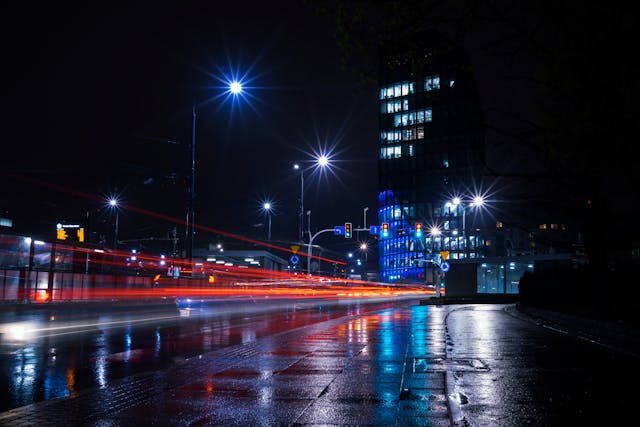
How does our night vision work? We have night vision because our eyes can use their rods, which are more sensitive to light. Night vision is technically called scotopic vision, which comes from the Greek skotos, which means darkness, and opia, which means sight.
Our eyes have two ways of detecting light. We have rods and we have cones. We have far more cones than rods and they are in different places. We use our cones to see during the day and to see color. We have roughly 6 million cones and they are all found in the center of the retina, which is the part at the back of the eye where light hits. The cones are divided into cones that can detect red, cones that can detect green, and cones that can detect blue. Whenever different light wavelengths hit the cones, they activate the cones that can detect different colors, and our brain puts all of the signals together to make an image. The brain knows that if it gets 60% red, 12% green, and 94% blue, that is purple. Our cones need a lot of light to function. Once it gets too dark, the cones can no longer receive signals, and we can’t use them.
We have roughly 120 million rods and they are mostly located around the outside of the retina, although there are many mixed in with the cones as well. The rods are far more sensitive to light than the cones. They can be activated by light that is 1,000 times lower than the light a cone needs. The photoreceptor in a rod can be activated by just a few photons of light. However, the rods are not capable of detecting color, they can only detect light, which is why our night vision is grey scale.
So, how does our night vision work? Our cones react to light during the day, and they give us all of the color information we need. They are located in the center of the retina, and they help us focus and make out detail. The cones react to light very quickly and they can adjust in a matter of minutes. If you switch the lights on in a dark room, you will blink and your eyes will be out of focus for a short while, but they will quickly adjust. These are the cones doing the work. The rods are mainly used for night vision, but we do also use them in the daytime. They give us information on changes in light, but they are generally too sensitive and don’t help much. It is at night that they come into their own. They are activated by very low levels of light and allow us to make out the general information of things and, as long as there is some light, see shades of grey. Because they are working on much lower levels of light, it can be difficult for us to judge distances and movement at night. We need a lot of visual information to work out motion. Also, because of their position around the edge of the retina, we can see much better at night if we use our peripheral vision. If you look out of the side of your eyes, rather than directly, you can see more. If you want to see stars, look out of the side of your eyes.
Our rods work with less light, but they take a lot longer to become active than the cones, It can take up to 45 minutes before they have 80% of their night vision ability and it can take a couple of hours to get to 100%. The rods have a nerve cell called rhodopsin that are only activated by low light. When they start detecting low light, the body starts producing more rhodopsin, and the more rhodopsin we have, the more we can see. It takes the body a long time to produce this chemical. Switching the lights on, or seeing a bright light, will activate the cones, destroying the rhodopsin in the rods, and you will have to start activating your night vision all over again. A lot of people who are out at night and need good night vision, such as astronomers or snipers, use red lights or red flashlights. The wavelength of the light is not high enough to destroy the rhodopsin and the night vision stays pretty much the same.
Incidentally, cats can see much better in the dark than we can because they have a layer of tissue called tapetum lucidum that reflects light into the cat’s eye, basically amplifying the available light. And this is what I learned today.
Try these
Sources
https://my.clevelandclinic.org/health/articles/24309-night-vision
https://www.cis.rit.edu/people/faculty/montag/vandplite/pages/chap_9/ch9p1.html
https://www.aao.org/eye-health/anatomy/cones
https://askabiologist.asu.edu/rods-and-cones
https://coopervision.com/blog/how-eyes-see-night
https://www.dynamicbrain.ca/night-vision.html
https://www.physicsforums.com/threads/do-rods-play-a-role-in-daytime-vision.969884
https://www.nps.gov/articles/dark-adaptation-of-the-human-eye-and-the-value-of-red-flashlights.htm
https://adsabs.harvard.edu/full/2013JRASC.107…20D
https://en.wikipedia.org/wiki/Scotopic_vision
Photo by Karol D: https://www.pexels.com/photo/time-lapse-photography-of-road-during-night-time-1013516/
